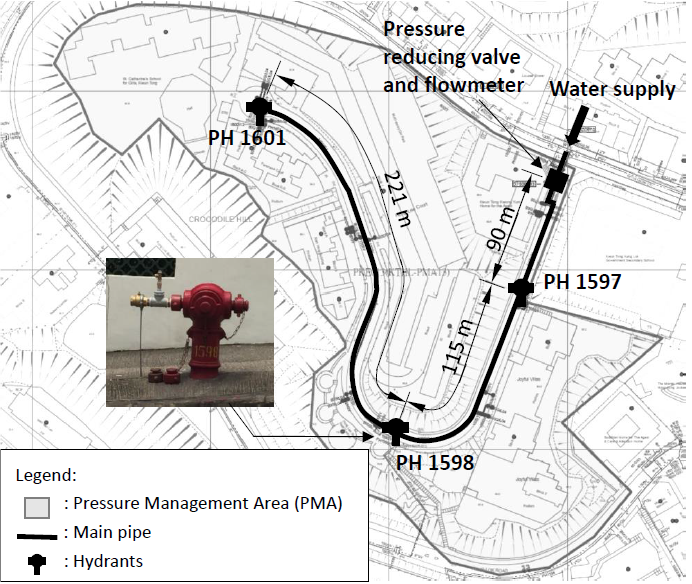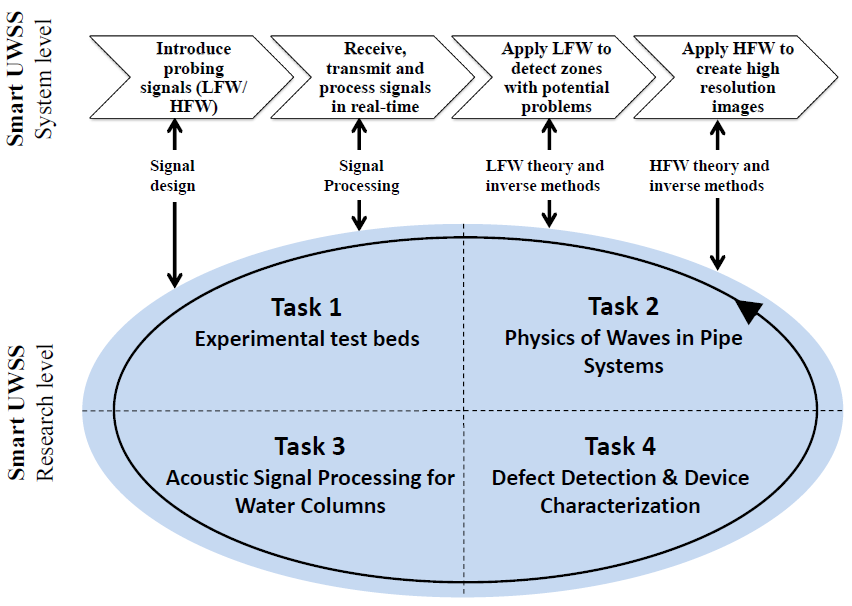Main Project Tasks and Deliverables
Task 1: Creating an experimental test bed for Smart UWSS research
Leader(s): Lee PJ, Lee JHW, Brunone B, Murch RD
Member(s): Karney BW, Zhang X, Meniconi S, Bermak A, Ghidaoui MS
Motivation:
The ultimate proof of a scientific theory is experimental validation.
The aim of this task is to develop a comprehensive HK based laboratory
and field validation program. We have secured support from the HK WSD
to use an existing DMA in Quarry Bay, HK, as a field test bed. Key
research issues related to the use of both LFW and HFW hydraulic
transients for fault detection will be investigated in targeted
experiments. Our vision is to develop a hitherto unavailable in-depth
understanding of hydraulic transients in the HK water supply system,
and to create new paradigms for the detection and identification of
faults and pipe conditions. This task will provide the data needed for
developing the fundamental principles and testing the underlying
mathematical models and theories (Tasks
2, 3)
for the next generation
of Smart UWSS
- a necessary step towards the development of intelligent
water networks in HK. This task will contain three phases where we
proceed from the testing of LFW (Phase 1) through to the laboratory and
field investigation of HFW in single pipelines in Quarry bay, HK (Phase
2) and finally the testing of the combined LFW and HFW pipe diagnostic
system in a custom built, highly controlled pipe network facility in
Nansha, China (Phase 3).
Objective(s):
The objectives are to: (i) develop the first Smart UWSS pipe
network
test bed in HK; (ii) study the use of LFW and HFW for active generation
of controlled transients and identification of system defects; (iii)
calibrate, verify and refine the models developed for LFW (1D &
quasi-2D) and HFW (2D & 3D) wave propagation, defect detection,
device characterization and air-water interaction in Tasks 2, 3, 4;
(iv) test the signal design, detection and processing strategies in
Task 3; (v)
transfer cutting-edge technology on pipeline condition
diagnostics to HK.
Deliverables
and Potential Benefits: The test bed and field tests will
provide the data, flow visualization and insights on the behavior of
LFW and HFW transients in a turbulent pipe flow and the effects of
noise, defects, hydraulic devices, air pockets, system scale and
geometry on wave propagation. Most importantly, the tests will result
in optimal signal generation mechanisms for different applications and
the identification of frequencies most suitable for in-pipe
communication. The coherent integration of theory, laboratory and field
tests will make a significant contribution to the development of
intelligent water networks in HK and internationally.
Task 2: Physics of Waves in Pipe Systems
Leader(s): Ghidaoui MS, Karney BW
Member(s): Xu K, Lee PJ, Brunone B, Duan HF, Murch RD, Zou J, Zhang X, Dimitrakopoulos I, Youcef-Toumi K
Motivation:
The proposed research seeks to create a diagnostic
framework where LFW provide the initial system reconnaissance (i.e., to
identify problematic sections or zones within the water network). HFW
are then applied as needed to zoom into regions and devices to produce
high resolution images that can identify anomalies and infer system
state. A necessary requirement for this inverse methodology is to
develop accurate and efficient models and algorithms of the probing
waves which entail better understanding of wave physics in pipes and
development of robust solution techniques.
Objective(s):
To develop, test, refine and prove mathematical models for
LFW and HFW that can be used to provide images of various resolutions
of pipe systems and devices in real-time.
Deliverables
and Potential Benefits: Calibrated, verified, stable and
accurate wave propagation numerical models that will be used in the
remaining tasks to investigate wave behavior in systems with different
scales and complexity; understanding and models of LFW&HFW
needed for Tasks 3,
4.
Task 3: Acoustic Signal Processing for Water Columns
Leader(s): Murch RD
Members(s): Zheng YR, McKay MR, Palomar DP, Lee PJ, Yang TC, Ghidaoui MS
Motivation:
Signal processing provides a framework for the estimation of essential
parameters needed for the detection of blockages, leaks and other forms
of pipe deterioration in the presence of interference and noise. For
example signal processing provides estimates of resonant frequencies
and transfer functions that are directly related to techniques for
detecting pipe defects in Task
4. Signal processing also provides
methods for increasing the accuracy of those estimates in the presence
of interference/noise and when limits on the probing wave amplitude are
imposed (Task 2).
Furthermore, if probing wave signals with lower
amplitudes than currently required can be designed, whilst maintaining
parameter estimation accuracy, then acoustic transducers could be
considered for generating the probing wave signals instead of valves.
This will vastly increase the signal processing and bandwidth possible
and hence the spatial resolution of the analyses. Signal processing can
also lead to novel approaches for signal communication along the water
column and reduce the number of external measurement access points
required in the Smart
UWSS
Objective(s):
To (i) develop channel signal models for water pipes that incorporate
the channel, noise and interference; (ii) use these models to develop
advanced signal processing techniques to optimize the probing wave
signal while minimizing its transmission power; (iii) develop
approaches for estimating key parameters needed in detecting pipe
defects and enhance their accuracy and; (iv) use signal processing
models to devise novel underwater communication techniques.
Deliverables
and Potential Benefits: Signal models for the acoustic
channel that include interference and noise; probing wave signals
optimized to enhance range and minimize uncertainty in the estimated
parameters; active parameter estimation techniques; water pipe
communications systems. These deliverables will provide the necessary
signal processing tools for Smart
UWSS.
Task 4: Defect Detection & Device Characterization by LFW and HFW
Leader(s):Ghidaoui MS
Member(s): Zou J, Duan HF, Brunone B, Meniconi S, Xu K, Lee PJ, Palomar DP, McKay MR, Karney BW, Katafygiotis LS
Motivation:
Task 2
asserts that leaks, blockages, bursts, deteriorated pipes, and
malfunctioning devices (pumps, valves) are not only ubiquitous and harm
system operation, but distort wave signals. This task specifically
seeks to use measured wave signals in an inverse sense to deduce the
system characteristics that caused the measured response. The key
motivation is to develop algorithms actually able to de-convolute
measured signals into a physical understanding of the system – that is,
into the constituents responsible for causing the observed response.
Expertise of team members at recognizing such signatures in LFW and
using them for defect detection is foundational for this task.
Objective(s):
To use the knowledge, facilities and models developed in Tasks 1, 2 and
signal processing methodologies in Task
3 to create long-range,
non-intrusive and reliable techniques to diagnose pipe systems on the
basis of measured signals of LFW and HFW.
Deliverables
and Potential Benefits: Innovative, long-range,
non-intrusive and reliable techniques for defect detection, device and
pipe-state characterization, early diagnosis and warning. This is
critical given that defects in current systems can result in water
losses of as much as 40% and the cost are far greater when concomitant
costs due to disruption of services, health risks and adverse
environmental impacts are considered. The Smart UWSS that will
emerge
and the research tasks that support its individual components are shown
below.
Outcome – Meeting the
Goals
& Mission of the Project: At the conclusion of the
research,
fundamental breakthroughs will have been made in forward and inverse
LFW&HFW problems in pipe systems. We will deliver proven tools,
techniques
and know-how to diagnose pipe systems in real-time, where a schematic
of the new diagnostic system along with the
research tasks that will make it possible is shown in the figure below.
The
outcome of the research will lay the foundations for the Smart UWSS to
be deployed in the field test area and implemented in other areas of HK
for
long term field testing; technology transfer to other cities is also
expected. The
fundamental breakthroughs and test beds together with the 20 PhD
students that
will be trained provide the foundations and impetus to ignite further
worldwide
research on high resolution “imaging” of pressurized pipe systems. This
research project will help realize HK’s WIN vision with a
notable impact
on the water infrastructure in Hong Kong and internationally.

